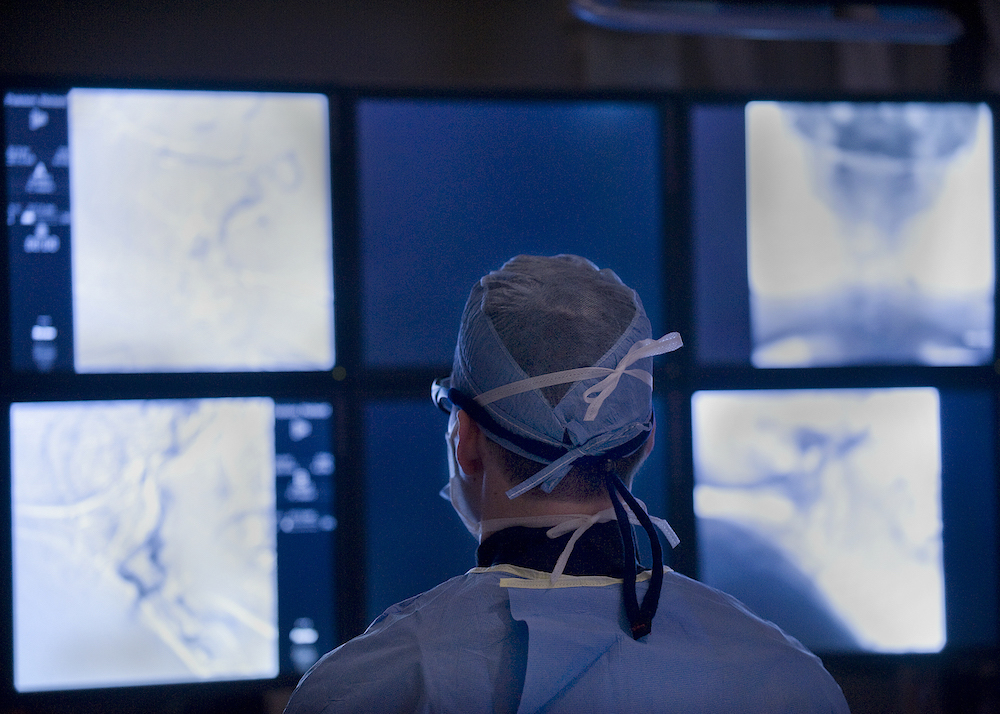A peek into the minds of those who operate on brains
April 16, 2019
After serving as a surgeon during World War I, Claude C. Coleman, M.D., returned to the Medical College of Virginia, his alma mater, in 1919. Having seen and treated horrific head injuries during the war, Coleman chose to focus his practice and teaching on the brain, marking the beginning of a dedicated neurosurgery practice at MCV. At that time, a typical brain surgery was what someone today would expect: An invasive craniotomy performed by a male doctor on a trauma patient strapped into a bed by a contraption resembling a birdcage.
One century later, the field of neurosurgery has seen significant advances. At what is now VCU Health, internationally renowned neurosurgeons and researchers are treating complex cases while pioneering new techniques and tools for diagnosis and treatment.
However, there is still much to discover about the body's most intricate organ. As neurosurgery at MCV/VCU Health turns 100, VCU News sat down with four VCU Health neurosurgeons to get their predictions on what the future holds for patients and practitioners.

Neurosurgeons will become experts in very specific areas and practice more collaboratively.
Neurosurgical residents learn to understand and treat the variety of ailments that affect the brain. Many residents are choosing to augment their education by devoting an extra year or two to further training in a subspecialty devoted to a specific disease area, said Alex Valadka, M.D., professor and chair of the VCU School of Medicine's Department of Neurosurgery.
“The more time you practice in a specific area, the better you get,” said Valadka, who recently served as president of the American Association of Neurological Surgeons and is currently a director of the American Board of Neurological Surgery. “As long as you practice critically with the intention of always improving, you will get very good at what you do.”
For example,Kathryn Holloway, M.D., a VCU Health neurosurgeon and professor of neurosurgery, for the past 15 years has focused on treatment and surgical advancements for people with movement disorders such as Parkinson's. That means Holloway's work has led to industrywide advances that help patients who need surgery, saidJohn Ward, M.D., former president of MCV Physicians.
“[She] decided long ago that she was going to specialize in a very small field,” Ward said. “Her work led to innovations that helped get rid of the cagelike frames used during surgeries, as well as implementing less-invasive surgical methods for those with seizures.”
This does not mean that subspecialty surgeons work in silos — far from it. “It's clear that everyone in neuroscience is going to be much more collaborative,” Valadka said.
A pediatric neurosurgeon will not be the sole doctor working on a child's neurological case. That surgeon, while knowing how best to operate on children with developing brains, will work closely with experts in child neurology, neuroradiology, radiation oncology, pediatric critical care, rehabilitation, nursing, pharmacy and other fields.
What does that mean for patients? They will be treated by a multidisciplinary team of all-stars.
Expect more women in white coats.

When Holloway applied to VCU's neurosurgery residency program in 1984, the surgeon who provided her recommendation told her she was the first woman he had ever considered recommending. According to the American Association of Neurological Surgeons, as recent as 2018 women constituted only 6% of practicing neurosurgeons certified by the American Board of Neurological Surgery and 8% of all practicing neurosurgeons in the country.
Holloway said she sees that changing.
The AANS elected the first female president in its 86-year history last year and, according to Holloway, the gender breakdown in classes has flipped since she was in medical school.
The trend of women entering the neurosurgery field, albeit slowly, echoes a trend across many industries.
“It wasn't just the establishments saying 'no' to women in the field. You had to devote intellectual capacity, be really tough, and available to respond at all hours,” Holloway said. “So it was women also asking themselves, 'How do I manage a family?' and 'Do I really want to do this?'”

Female neurosurgeons can manage it all, and are in high demand, Holloway said. “I think our challenge is to help women understand that yes, this looks crazy and a little different, but it's really worth it.”
Harold F. Young, M.D., director of the VCU Health Harold F. Young Neurosurgical Center, sees evidence of a changing landscape of demographics in neurosurgery, and a future of more females.
“Women don't see a glass ceiling anymore. They're going to change us,” said Young, who has taught hundreds of students in his nearly 50 years at VCU Health. When asked what makes a good surgeon, Young said, “The eyes of an eagle, the heart of a lion, and the hands of a woman.”
Deep brain stimulation will become predictive and responsive, and an unexpected option for people with psychiatric disorders.
Deep brain stimulation is a surgical treatment to reduce symptoms in patients with Parkinson's disease, essential tremor, dystonia, Tourette syndrome, obsessive-compulsive disorder and epilepsy. It involves targeting a well-controlled electrical current into a specific area of the brain andfunctions like alight dimmer: Physicians can increase or decrease the level of electric current with a dial.
In the near future, Holloway predicts the implantable device that administers DBS will become predictive and responsive based on the patient's needs.
“It will be able to sense when the brain needs a little nudge, and automatically deliver it,” she said. “We're currently only using sensors with epilepsy patients, but we're working hard to bring it to other disease areas.”

Valadka and Holloway foresee that neurosurgeons will also start using DBS in patients who suffer from other neurological diseases, including those that involve mood or cognitive circuits, such as depression, anxiety, dementia and brain injury.
“There are very preliminary studies on treating depression or obsessive-compulsive disorder with deep brain stimulation,” Valadka said. “Imagine if we could address conditions like substance abuse or overeating and obesity by stimulating part of your brain.”
If it is a brain circuit problem, it can be treated with DBS, Holloway said. “People think that psychiatric diseases are something different from neurologic diseases, but the symptoms all arise from imbalanced brain circuits. I always tell people to remember 'The Matrix': It is all in your head.”
Smaller scars, shorter recovery time, bigger gains.

The days of large craniotomies are going away. Neurosurgeons are already using methods such as laser ablation and radiosurgery to “zap” brain tumors with beams, resulting in minimal damage to healthy tissue, submillimeter accuracy and zero incisions.
Hospitals' investments in the latest neurosurgical technology are opening up new avenues for better outcomes during and after surgery, as well as shorter stays. According to Ward, who has had a front-row seat to the evolution of brain and spine operations over his 40-year career, methods like these will only continue to benefit patients.
“When I look forward, and even now, I see more robotics involved in performing less-invasive procedures,” he said.
“The big operations many of us learned in training — like taking apart half of a skull — won't be as common in the future,” said Valadka, who noted neurosurgeons are already operating in ways patients would not expect. “With radiosurgery, you're really sitting in a control room and programming a computer to deliver radiation to a precisely targeted area.

“A wise neurosurgeon once told me that any surgical procedure needs to be like a military exercise. You need an objective, a way in and a way out,” Valadka said. “So that's how we think [before operating]. What is the goal here, and what's the most efficient way to do it?”
All four VCU Health neurosurgeons agreed: Neurosurgery is a field that is advancing at a rapid pace and surgeons will only get more precise as they uncover new ways of performing operations. Patients should expect more options, less-invasive procedures and faster recovery.




.jpg)